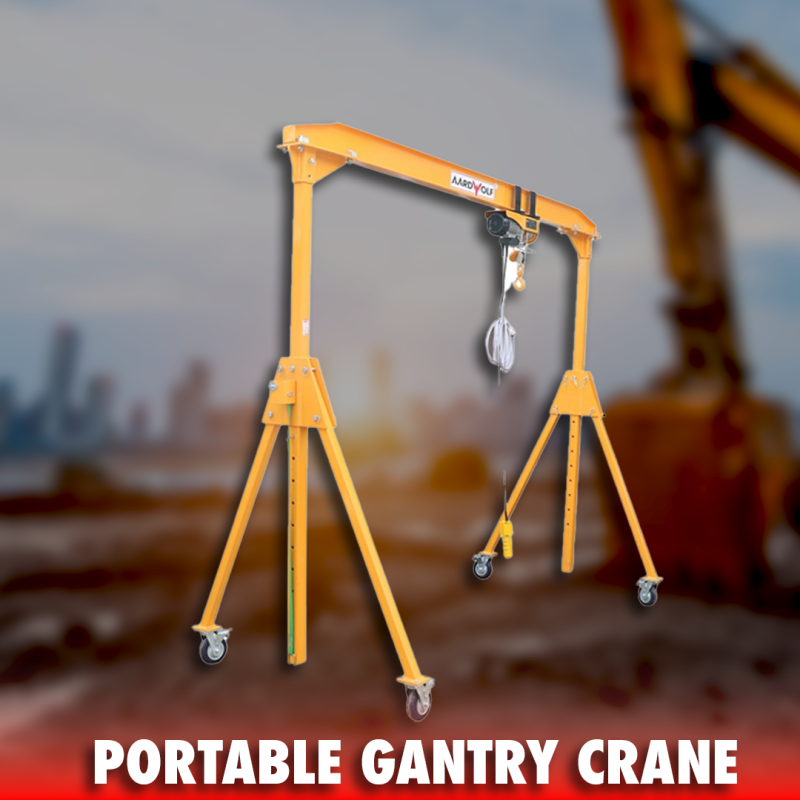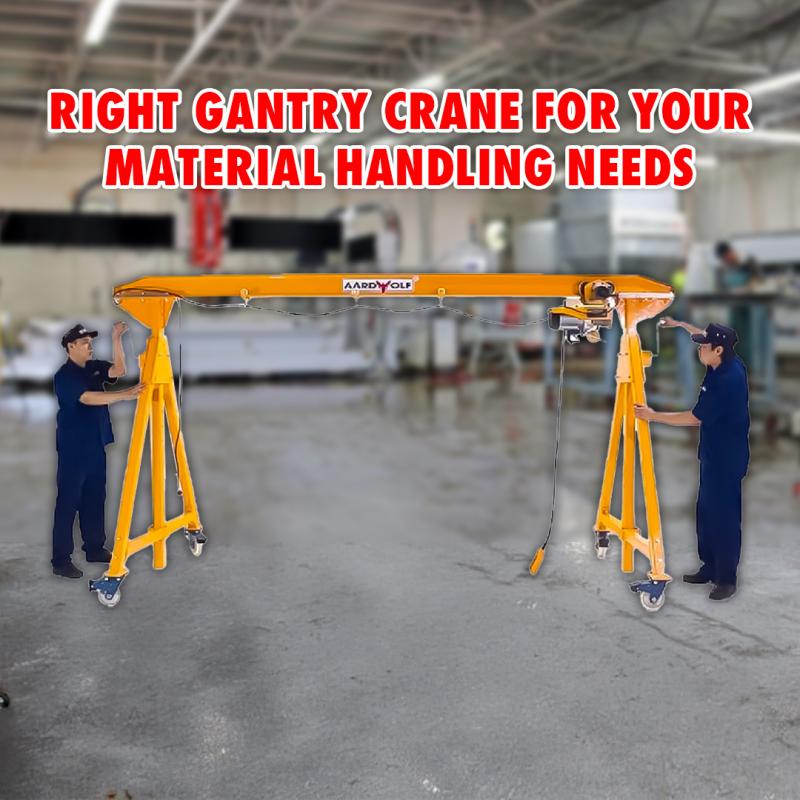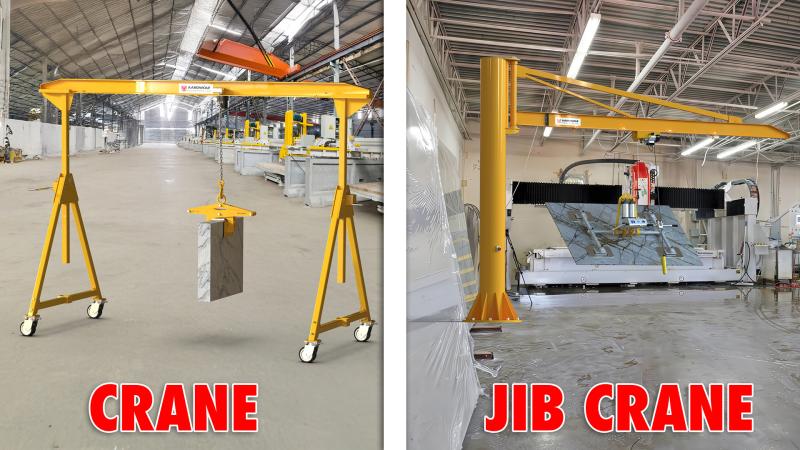



From construction yards to stone workshops, these cranes provide a safe, efficient, and cost-effective way to lift and move heavy items. Whether you’re a manufacturer, contractor, or fabricator, understanding how gantry cranes work—and how to select the right one—can dramatically improve your workflow.
This beginner’s guide will walk you through what a gantry crane is, how it works, the different types available, and how products like those from Aardwolf Industries are applied in real-world operations.
A gantry crane is a type of overhead lifting device that uses a bridge-like structure supported by two vertical legs. This bridge (or girder) supports a hoist and trolley that move horizontally across it. The crane lifts loads vertically using the hoist and moves them horizontally via the trolley, with the entire crane structure either fixed in place or mobile on wheels or rails.
Freestanding structure – no need for ceiling or wall support
Flexible installation – can be stationary or mobile
Supports heavy and light loads
Suitable for both indoor and outdoor use
A gantry crane stands on its own, with legs that touch the ground. A bridge crane, on the other hand, is installed overhead and is fixed to building supports. Gantry cranes are preferred when installing a bridge crane is too expensive, impractical, or not physically possible.
Bridge/Girder – The horizontal beam that spans across the crane, supporting the trolley and hoist.
Legs/Supports – Upright columns that support the girder. They may be A-frame or straight-leg designs.
Hoist – The lifting mechanism, powered either manually or electrically.
Trolley – A motorized or manual carriage that moves the hoist across the bridge.
Wheels or Rails – Allow the entire crane to travel across a floor or track.
Control System – Includes push-button pendant, remote control, or fixed panel.
Let’s break down the most common types of gantry cranes and how they are used—along with specific examples of Aardwolf crane models in real-world environments.
Definition: These have two legs that ride on floor-mounted rails or wheels. They span an entire work area and can support very large loads.
Common Uses:
Rail yards lifting containers
Precast concrete handling
Steel mills transporting beams or coils
Example:
A construction company building bridges uses a full gantry crane to move massive pre-tensioned concrete slabs from casting beds to staging areas. They install a rail system in the yard, allowing the gantry to span the entire production line.
Definition: One leg rides on wheels/rails while the other side runs along an elevated runway (typically mounted to a wall).
Common Uses:
Industrial plants
Assembly lines
Fabrication areas
Example:
In a steel fabrication plant, a semi-gantry crane moves large steel parts along a wall-mounted track, while forklifts and welders work below without obstruction.
Definition: Smaller, mobile cranes equipped with casters or rubber wheels. Easy to move, set up, and reposition.
Common Uses:
Workshops and garages
Small-scale lifting and repairs
Engine installation and maintenance
Aardwolf Example:
The Aardwolf AGC-1500 (1.5m span) or AGC-3000 (3m span) are popular in fabrication shops. A technician uses the crane to lift granite slabs from A-frames onto saw tables. When not in use, the crane is rolled aside, freeing up space.
Definition: Allow vertical and horizontal adjustment of the bridge, height, and sometimes leg width.
Common Uses:
Varying load sizes
Facilities with low ceilings or tight clearances
Job sites requiring flexible equipment
Aardwolf Example:
In a custom kitchen countertop shop, workers use an Aardwolf Adjustable Gantry Crane with variable height to lift heavy marble slabs while maneuvering under ceiling-mounted ventilation systems. They adjust the height as needed to move slabs between the showroom and cutting stations.
Position the Crane: Roll the gantry crane into place (if mobile) above the load to be lifted.
Secure the Load: Use appropriate lifting attachments (like clamps or vacuum lifters).
Lift the Load: Raise the hoist slowly, ensuring balance and stability.
Move Horizontally: Traverse the trolley along the beam or move the crane to another area.
Lower the Load: Gently place the load in its new position.

Problem: Moving delicate and heavy slabs of granite or glass
Solution:
An Aardwolf Portable Gantry Crane + Vacuum Lifter Combo allows workers to safely handle slabs without chipping or scratching the surface. The crane can be wheeled across the workshop and adjusted for height. Workers attach an Aardwolf Vacuum Glass Lifter (AVGLP2) to a 250kg glass sheet, lift it, and rotate it onto the polishing table.
Problem: Removing and reinstalling heavy engines in a garage setting
Solution:
A one-ton Aardwolf AGC Crane with a chain hoist is used to lift engines out of sedans and small trucks. Its compact design allows the mechanic to move it around lifts and toolboxes, and it can be rolled out of the way when not needed.
Problem: Lifting pre-cast concrete pieces outdoors with no overhead support
Solution:
A full gantry crane installed with weather-resistant coatings, galvanized legs, and rotating axle end trucks allows workers to move heavy pre-cast panels across an open job site. A protective hoist cover (“doghouse”) shields electrical components from rain.
Light-duty: 1–5 lifts per hour (portable gantry cranes)
Moderate-duty: 5–10 lifts per hour (adjustable/semi-gantry)
Heavy-duty: Continuous lifting, large loads (full gantry)
Indoor cranes: Powder-coated or painted steel is sufficient
Outdoor cranes: Use galvanized or stainless steel with protective enclosures
Portable: Casters for full mobility (Aardwolf AGC)
Fixed: For repetitive lifting in a dedicated zone
Rail-mounted: For large-scale yards and linear transport
Manual chain hoists (light lifting, lower cost)
Electric hoists with long extension cords or cable reels
Remote control or pendant systems for safety
 Why Choose Aardwolf Gantry Cranes?
Why Choose Aardwolf Gantry Cranes?Aardwolf Industries designs and manufactures lifting solutions tailored to the stone, glass, construction, and maintenance sectors. Their gantry crane lineup includes:
AGC-1500/2000/3000: Compact, portable, and durable gantry cranes
Adjustable Height Gantries: Versatile for tight, complex workspaces
Gantry + Vacuum Lifter Packages: Complete solutions for slab, panel, and sheet handling
Lightweight aluminum construction
Quick assembly with bolt-together design
Designed for integration with Aardwolf clamps, trolleys, and vacuum lifters
Industry-specific accessories available

Gantry cranes are essential for businesses needing flexible, freestanding lifting systems without complex installations. Whether you’re lifting precast panels, engines, stone slabs, or heavy tools, a gantry crane provides reliable performance with minimal setup.
For shops and sites seeking cost-effective, portable, and durable lifting, Aardwolf gantry cranes offer unmatched value—especially when paired with their full range of material handling attachments.
References
1. How to operate a Jib Crane safely
3. Over brace jib crane wall mounted
5. Is a Jib Crane a Gantry Crane
6. Articulated Jib Crane Wall Mounted
8. Manual Counterbalance Crane
10. Over Braced Jib Crane Column Mounted
Sign up to receive the latest info on new Aardwolf products, special offers and more.
By signing up you agree to receive emails from Aardwolf with news, special offers, promotions and other information. You can unsubscribe at any time.